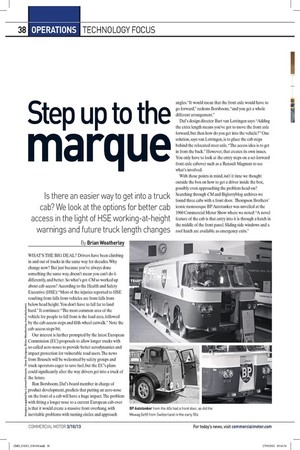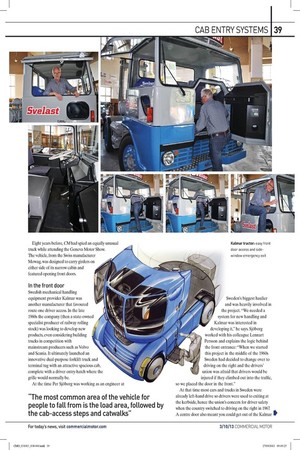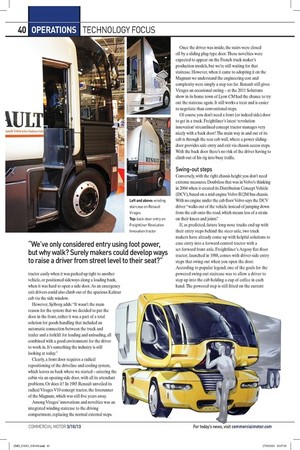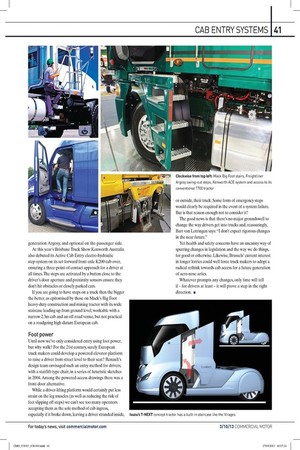Step up to the marque
Page 30

Page 31

Page 32

Page 33

If you've noticed an error in this article please click here to report it so we can fix it.
Is there an easier way to get into a truck cab? We look at the options for better cab access in the light of HSE working-at-height warnings and future truck length changes By Brian Weathertey
WHAT'S THE BIG DEAL? Drivers have been climbing in and out of trucks in the same way for decades. Why change now? But just because you've always done something the same way, doesn't mean you can't do it differently, and better. So what's got CMso worked up about cab access? According to the Health and Safety Executive (HSE): "Most of the injuries reported to HSE resulting from falls from vehicles are from falls from below head height. You don't have to fall far to land hard." It continues: "The most common area of the 2 vehicle for people to fall from is the load area, followed by the cab-access steps and fifth-wheel catwalk." Note the Icab-access steps bit. Our interest is further prompted by the latest European .r2 Commission (EC) proposals to allow longer trucks with
so-called aero-noses to provide better aerodynamics and . g impact protection for vulnerable road users. The news from Brussels will be welcomed by safety groups and g truck operators eager to save fuel, but the EC's plans 2 could significantly alter the way drivers get into a truck of
the future. Ron Borsboom, Daf's board member in charge of product development, predicts that putting an aero-nose 7, on the front of a cab will have a huge impact. The problem gwith fitting a longer nose to a current European cab-over g is that it would create a massive front overhang, with 2 inevitable problems with turning circles and approach
angles. "It would mean that the front axle would have to go forward," reckons Borsboom,"and you get a whole different arrangement."
Daf's design director Bart van Lotringen says: "Adding the extra length means you've got to move the front axle forward, but then how do you get into the vehicle?" One solution, says van Lotringen, is to place the cab steps behind the relocated steer-axle. "The access idea is to get in from the back." However, that creates its own issues. You only have to look at the entry steps on a set-forward front-axle cabover such as a Renault Magnum to see what's involved.
With those points in mind, isn't it time we thought outside the box on how to get a driver inside the box, possibly even approaching the problem head-on? Searching through CM and Biglorryblog archives we found three cabs with a front door. Thompson Brothers' iconic monocoque BP Autotanker was unveiled at the 1960 Commercial Motor Show where we noted: "A novel feature of the cab is that entry into it is through a hatch in the middle of the front panel. Sliding side windows and a roof hatch are available as emergency exits." Eight years before, CM had spied an equally unusual
truck while attending the Geneva Motor Show.
The vehicle, from the Swiss manufacturer Mowag, was designed to carry girders on either side of its narrow cabin and featured opening front doors. In the front door Swedish mechanical handling equipment provider Kalmar was another manufacturer that favoured route one driver access. In the late 1960s the company (then a state-owned specialist producer of railway rolling stock) was looking to develop new products, even considering building trucks in competition with mainstream producers such as Volvo and Scania. It ultimately launched an
innovative dual-purpose forklift truck and terminal tug with an attractive spacious cab, complete with a driver entry-hatch where the grille would normally be. At the time Per Sjoborg was working as an engineer at Sweden's biggest haulier and was heavily involved in the project. "We needed a system for new handling and Kalmar was interested in developing it," he says. Sjoborg worked with his colleague Lennart Persson and explains the logic behind the front entrance: "When we started this project in the middle of the 1960s Sweden had decided to change over to driving on the right and the drivers' union was afraid that drivers would be injured if they climbed out into the traffic,
so we placed the door in the front." At that time most cars and trucks in Sweden were already left-hand drive so drivers were used to exiting at the kerbside, hence the union's concern for driver safety when the country switched to driving on the right in 1967. A centre door also meant you could get out of the Kalmar tractor easily when it was parked up tight to another vehicle, or positioned sideways along a loading bank, when it was hard to open a side door. As an emergency exit drivers could also climb out of the spacious Kalmar
cab via the side window.
However, Sjoborg adds: "It wasn't the main reason for the system that we decided to put the door in the front, rather it was a part of a total solution for goods handling that included an automatic connection between the truck and trailer and a forklift for loading and unloading, all combined with a good environment for the driver to work in. It's something the industry is still looking at today."
Clearly, a front door requires a radical repositioning of the driveline and cooling system, which leaves us back where we started — entering cabin via an opening side door, with all its attendant problems. Or does it? In 1985 Renault unveiled its radical Virages V10 concept tractor, the forerunner of the Magnum, which was still five years away.
Among Virages' innovations and novelties was an integrated winding staircase to the driving compartment, replacing the normal external steps.
Once the driver was inside, the stairs were closed off by a sliding plug-type door. These novelties were expected to appear on the French truck maker's production models, but we're still waiting for that staircase. However, when it came to adopting it on the Magnum we understand the engineering cost and complexity were simply a step too far. Renault still gives Virages an occasional outing — at the 2011 Solutrans show in its home town of Lyon CM had the chance to try out the staircase again. It still works a treat and is easier to negotiate than conventional steps.
Of course you don't need a front (or indeed side) door to get in a truck. Freightliner's latest 'revolution innovation' streamlined concept tractor manages very nicely with a back door! The main way in and out of its cab is through the rear cab wall, where a power slidingdoor provides safe entry and exit via chassis access steps. With the back door there's no risk of the driver having to climb out of his rig into busy traffic. Swing-out steps Conversely, with the right chassis height you don't need extreme measures. Doubtless that was in Volvo's thinking in 2004 when it created its Distribution Concept Vehicle (DCV), based on a mid-engine Volvo B12M bus chassis. With no engine under the cab floor Volvo says the DCV driver "walks out of the vehicle instead of jumping down from the cab onto the road, which means less of a strain on their knees and joints': If as predicted, future long-nose trucks end up with their entry steps behind the steer-axle, two truck makers have already come up with helpful solutions to ease entry into a forward-control tractor with a set-forward front-axle. Freightliner's Argosy flat-floor tractor, launched in 1988, comes with driver-side entry steps that swing out when you open the door. According to popular legend, one of the goals for the powered swing-out staircase was to allow a driver to step up into the cab holding a cup of coffee in each hand. The powered step is still fitted on the current
generation Argosy, and optional on the passenger side.
At this year's Brisbane Truck Show Kenworth Australia also debuted its Active Cab Entry electro-hydraulic step-system on its set-forward front-axle K200 cab-over, ensuring a three-point-of-contact approach for a driver at all times. The steps are activated by a button close to the driver's door aperture and proximity sensors ensure they don't hit obstacles or closely parked cars.
If you are going to have steps on a truck then the bigger the better, as epitomised by those on Mack's Big Foot heavy-duty construction and mining tractor with its wide staircase leading up from ground level; workable with a narrow 2.3m cab and an off-road venue, but not practical on a roadgoing high-datum European cab. Foot power
Until now we've only considered entry using foot power, but why walk? For the 21st century, surely European truck makers could develop a powered elevator platform to raise a driver from street level to their seat? Renault's design team envisaged such an entry method for drivers, with a stairlift-type chair, in a series of futuristic sketches in 2004. Among the powered-access drawings there was a front-door alternative. While a driver-lifting platform would certainly put less strain on the leg muscles (as well as reducing the risk of feet slipping off steps) we can't see too many operators accepting them as the sole method of cab ingress, especially if it broke down, leaving a driver stranded inside,
or outside, their truck. Some form of emergency steps would clearly be required in the event of a system failure. But is that reason enough not to consider it?
The good news is that there's no major groundswell to change the way drivers get into trucks and, reassuringly, Bart van Lotringen says: "I don't expect rigorous changes in the near future."
Yet health and safety concerns have an uncanny way of spurring changes in legislation and the way we do things, for good or otherwise. Likewise, Brussels' current interest in longer lorries could well force truck makers to adopt a radical rethink towards cab access for a future generation of aero-nose artics. Whatever prompts any changes, only time will tell if — for drivers at least — it will prove a step in the right direction. •











































